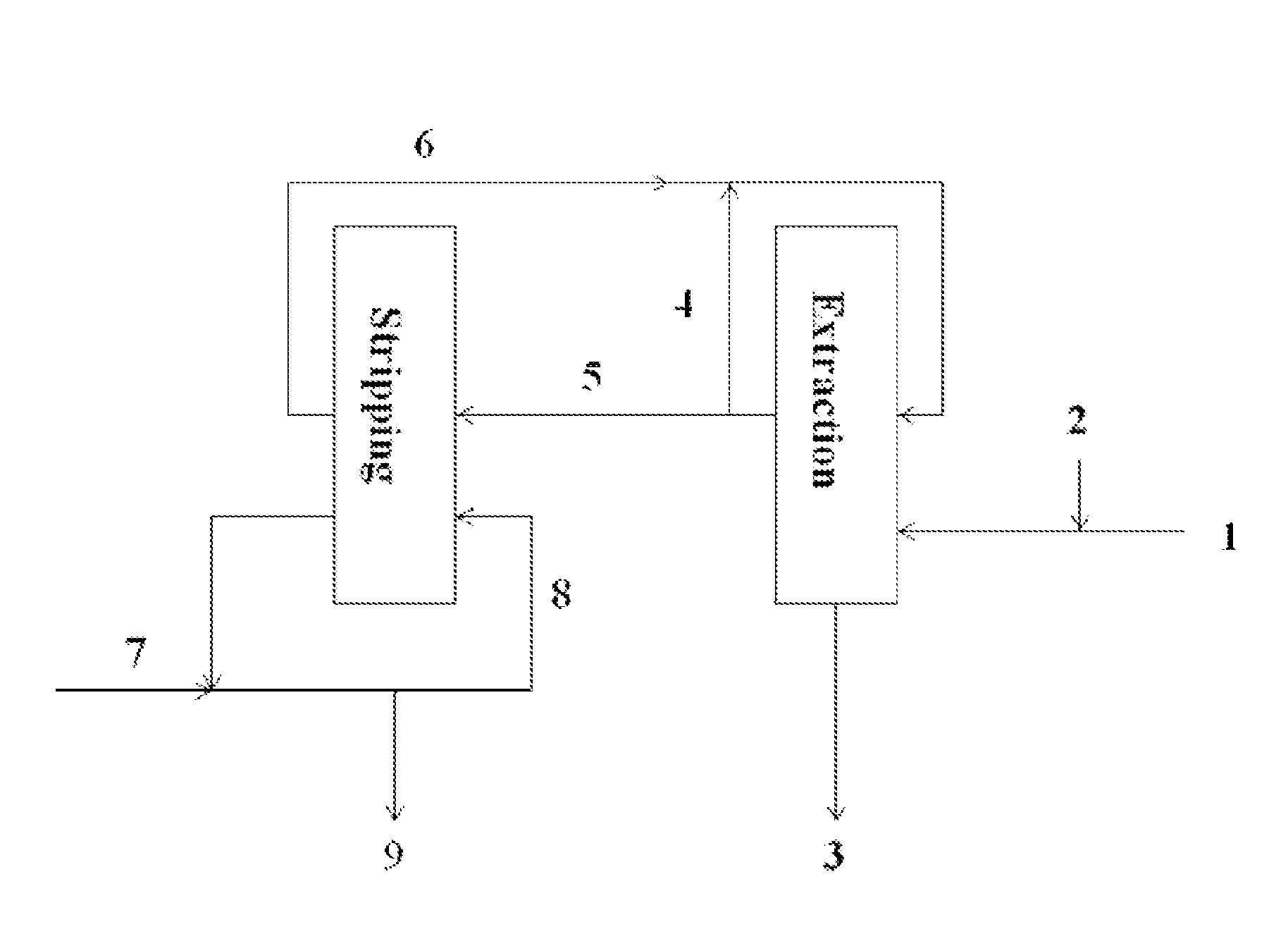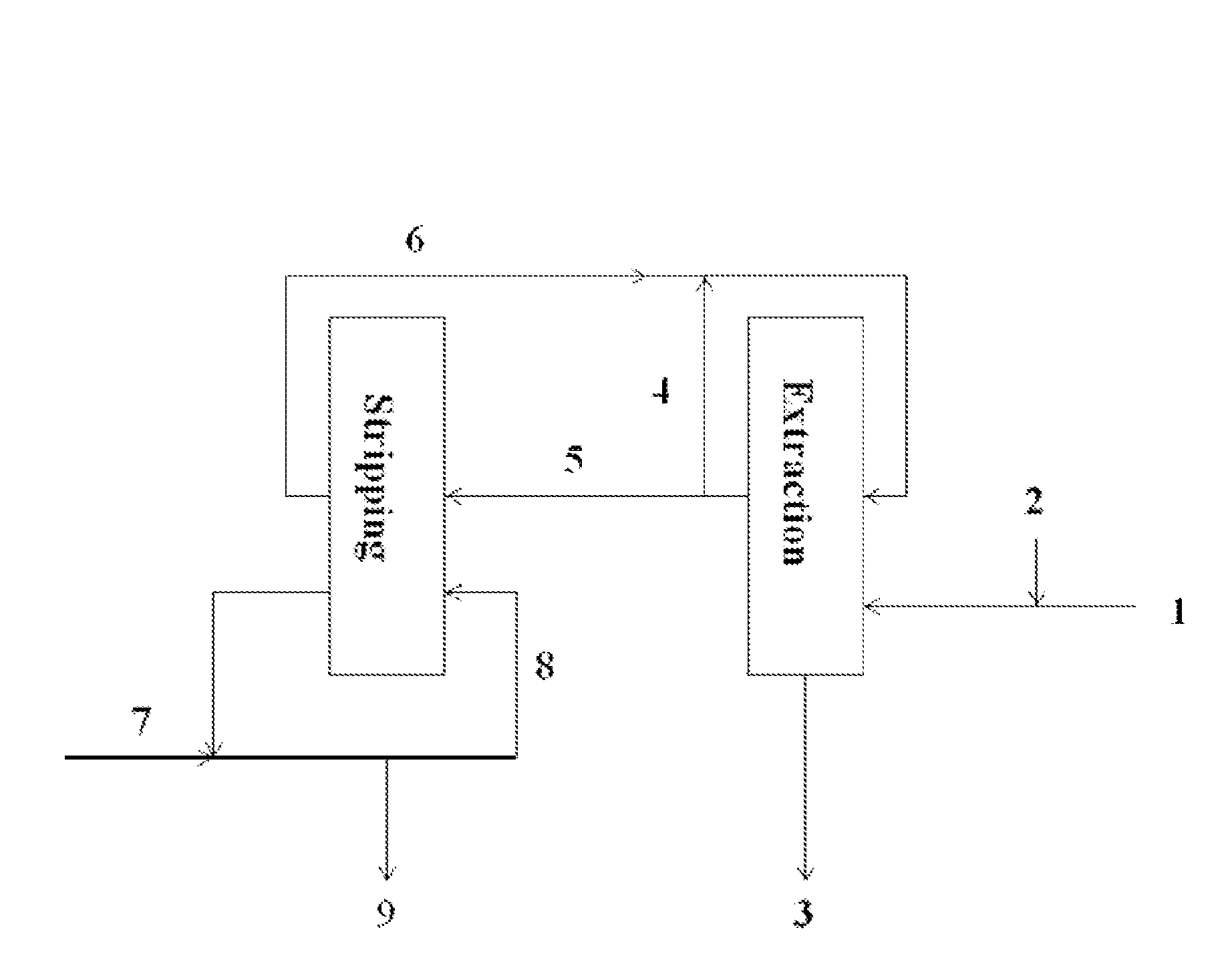Processes for recovering metals from aqueous solutions
a technology of aqueous solutions and metals, which is applied in the field of process for the recovery of metals from aqueous solutions, can solve the problems of less efficient exchange performance, large variability of feed solutions, and reduction of mass transfer coefficients, and achieves efficient and economic recovery. , the effect of good mixing properties
- Summary
- Abstract
- Description
- Claims
- Application Information
AI Technical Summary
Benefits of technology
Problems solved by technology
Method used
Image
Examples
example 1
[0140]0.1 M phosphinic acid reagent bis(2,4,4-trimethylpentyl)-phosphinic acid dissolved in ORFORM®-SX 7 solvent is used as the organic phase. The aqueous phase used in this example is a synthetic aqueous solution containing 1.6 g / l Cu, 4 g / l Fe, 6.5 g / l Al, 25 ppm Co and 25 ppm Mo and the pH is adjusted to 1.06 using sulfuric acid. All the metals used to make the synthetic aqueous solution are sulfate salts. Equal volumes of organic and aqueous phases are magnetically stirred for 30 min and both phases are sampled for Inductive Coupled Plasma Optical Emission Spectroscopy (ICP-OES) analysis. The pH of the aqueous phase is adjusted to 0.95 using sulfuric acid and the biphasic system is magnetically stirred for 30 minutes and sampled for ICP-OES analysis. The procedure is repeated at different pH values (pH=0.65, pH=0.43, and pH=0.03). The results are used to calculate the percentage of metals extracted in the organic phase shown in Table 1 and indicate that molybdenum is preferentia...
example 2
[0142]Phosphinic acid reagent in ORFORM® SX-7 with 1.5% modifier and without modifier is loaded at a 1:2 metallurgical O / A ratio with an aqueous feed solution containing 4.8 g / l Mo, 2.7 g / l Fe, 6.3 g / l Al, 0.6 g / l Cu and a pH=0.4. The biphasic system is magnetically stirred 1 hour and then the phases are separated, filtered through phase separating paper (the organic phase) and regular filter paper (the aqueous phase) and the two phases are analyzed by ICP-OES. The organic phases are subsequently used for stripping experiments. The stripping solution consists of an aqueous solution containing 0.5 M NH4OH / 0.25 M (NH4)2CO3. The organic loading from the aqueous analysis indicates about 5 g / l Mo in the organic phase.
[0143]Table 2 shows the molybdenum loading on the organic phase after extraction.
[0144]
TABLE 2ModifierMo, org, ppmTridecanol5,029Alfol 10125,010Alfol 10145,022TXIB5,325No modifier5,587
[0145]The results in Table 2 show that the addition of modifier only slightly reduces molyb...
example 3
[0148]A raffinate from a Cu SX plant is adjusted to a pH=0.43 with sulphuric acid and contacted with 0.1 M phosphinic acid reagent in ORFORM® SX-7 at a metallurgical O:A=1. The sample contains 5.7 g / l Al, 0.65 g / l Cu, 4.7 g / l Fe, 63 ppm Mo, 9 ppm V, 33 ppm U, 10.3 ppm Ti and other metals as shown in Table 4. The biphasic system is magnetically stirred for 30 min, phase separated and the organic phases are sampled for ICP-OES analysis. The organic phase is contacted with a fresh aqueous solution at the same metallurgical O:A ratio (1:1), equilibrated under magnetic stirring and the organic phase is sampled for ICP-OES analysis. This procedure is repeated and the organic samples are analyzed by ICP-OES. The results are presented in Table 5 and show that molybdenum is concentrated in the organic phase. Uranium is also extracted and follows the same trend. On the other hand, the concentration of iron in the organic phase did not change significantly during the extraction. Thus, the extr...
PUM
| Property | Measurement | Unit |
|---|---|---|
| concentration | aaaaa | aaaaa |
| concentration | aaaaa | aaaaa |
| concentration | aaaaa | aaaaa |
Abstract
Description
Claims
Application Information
 Login to View More
Login to View More - R&D
- Intellectual Property
- Life Sciences
- Materials
- Tech Scout
- Unparalleled Data Quality
- Higher Quality Content
- 60% Fewer Hallucinations
Browse by: Latest US Patents, China's latest patents, Technical Efficacy Thesaurus, Application Domain, Technology Topic, Popular Technical Reports.
© 2025 PatSnap. All rights reserved.Legal|Privacy policy|Modern Slavery Act Transparency Statement|Sitemap|About US| Contact US: help@patsnap.com



